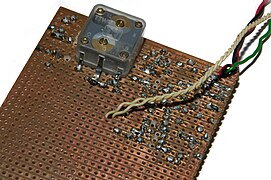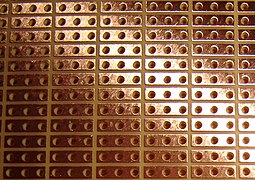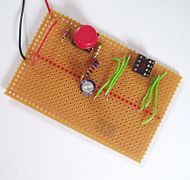Practical Electronics/Perfboard
There are many types of prototyping boards.
The vast majority of such boards are perforated at 0.1 inch (2.54mm) pitch (one hole each 0.1 inch/2.54mm) both horizontally and vertically (also called "tenth inch spacing"), made out of either "synthetic resin bonded paper" or fiberglass, and have some kind of copper pattern on one or both sides of the board.
Perhaps the most popular pattern is the "stripboard" -- which has wide strips of copper running one way all the way along one side of the board, but no copper on the other side. However, this type of board (and perfboards in general) will require soldering for the circuits to be able to function properly.
The other common type of prototype boards is the solder-less prototyping board also known as a breadboard.
-
close up of unused Veroboard
-
buzzer made using stripboard
-
Because the strips (copper traces on the solder side) run left-and-right, the components (on the component size) usually run up-and-down.
-
component side of AM receiver
-
solder side of same AM receiver. DIP integrated circuits usually require traces to be cut between their 2 rows of pins
-
Complex circuits, such as Dolby SR, have been built on stripboard.
-
close up of unused "3-Hole Solder Pad" prototyping board, also called "TriPad"
-
simple circuit using stripboard (component side)
-
Breadboard
-
Longer breadboard









